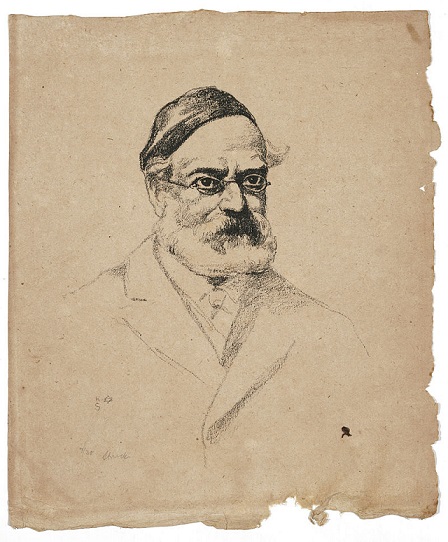For most German Jews, the first decades of the nineteenth century were a period of relentless change. In large parts of western Germany, they had been emancipated and granted civil rights thanks to the Enlightenment and the Napoleonic occupation, only to swiftly become second-class citizens all over again when the French troops retreated in 1814. Among Jews, however, the winds of change kept blowing.
A variety of new groups sprouted up throughout Germany, first and foremost the Reform movement, which sought to reshape contemporary Judaism into a “German” religion. The reformists shortened services, modified aspects of the liturgy, introduced German-language prayers, and added choral singing accompanied by organ music. Jewish religious laws were relaxed, and some prayers, such as for the restoration of the Temple, were phased out as antiquated. Some congregations even moved Shabbat observances to Sundays. Yet for Rabbi Samson Raphael Hirsch (20 Jun 1808 – 31 Dec 1888), the main intellectual pioneer and de-facto founder of Neo-Orthodoxy, the Torah remained the touchstone for the Jewish people. At the same time, he welcomed Jews’ emancipation. And, like the reformers, he advocated religious Jews and future rabbis attending university to improve their career opportunities, a stance that many Jews in eastern Europe considered unthinkable. Hirsch did, in fact, seek profound changes. He was motivated by a question that holds equally crucial significance for other religions today: “How can the German-Jewish people exist in two cultures at once?” Many Jews who drew inspiration from Moses Mendelssohn and his ambitions for equal rights acted as German citizens in public and as Jews at home and at synagogue. Hirsch’s new ideal, by contrast, was a figure he called the Israel-Mensch, someone living in society’s midst who existed within two civilizations at once, possessing well-rounded education in both spheres and identifying with both alike. His most important work, The Nineteen Letters, examines conventional Orthodox practice through an intellectually inspirational yet highly critical lens. In its pages, the Orthodox reformer developed his concept of “Torah im Derekh Eretz,” or “Torah with the way of the world.” This appeal to Jews to embrace non-Jewish culture and education was released in 1836 and attracted significant attention. Well-known Jews such as the historian Heinrich Graetz were drawn to this modern approach and sought to study under the rabbi. For Hirsch, there was no contradiction between Germanness and strict adherence to Jewish religious law. On the contrary, in his view, the obligation towards the secular world derived directly from the Torah and the Talmud, and he cited a line from the prophet Jeremiah and a section from Pirkei Avot (Chapters of the Fathers) as sources. Hence, a Jew’s religious duties included not only the study of Torah, but also secular education and the exercise of patriotism. “Tora im Derekh Eretz” became the central doctrine of Neo-Orthodoxy and soon influenced Orthodox Judaism at large.
In 1876, Hirsch managed to secure the passage of the Secession Law at the Prussian Landtag (diet, or assembly), authorizing Orthodox Jewish congregations to secede from the official Jewish communities, or Gemeinden, which Hirsch felt were domineered by liberal-minded Jews. The first such secessionist Orthodox synagogue had been built in the 1850s on Frankfurt’s Schützenstrasse, and Samson Raphael Hirsch was soon appointed as its rabbi. Fifty years later, it was followed by the newly constructed Friedberger Anlage, one of the grandest Jewish houses of worship in Europe. However, Orthodox Jews only pursued this successionist model in a few places. The more common setup in pre-Holocaust Germany remained a unified Jewish Gemeinde for a whole city or region. This Gemeinde would encompass both reform and Orthodox synagogues, which practiced different rites but operated other community institutions such as cemeteries collectively.
Hirsch established schools that provided both religious and secular education as well as corresponding teachers’ training colleges. But he left his greatest mark through Berlin’s Neo-Orthodox rabbinical seminary, founded in 1873. Fully committed to the principle of “Torah im Derekh Eretz,” most graduates departed this institute for higher education as “doctor-rabbis”: alongside their religious training, they had also completed doctorates in a secular subject at the university. Although the seminary’s founder, Azriel Hildesheimer, continued to combat Reform Judaism, subsequent generations grew more open to dialogue and cooperation with their liberal counterparts. One of the seminary’s most prominent students, Nehemia Nobel (8 Nov 1871–24 Jan 1922) became a rabbi at the Orthodox synagogue on Börneplatz within Frankfurt’s united community, a synagogue built in response to the secessionists. Nobel supported the philosopher of religion Franz Rosenzweig by appointing him director of the Jewish Lehrhaus (House of Learning) in Frankfurt. A second major rabbi who advanced the seminary was Josef Carlebach (30 Jan 1883 – 26 Mar 1942), active in Altona and later Hamburg. In addition to his training at the Orthodox seminary, Carlebach completed a comprehensive scientific education at the university, where his instructors included none other than Max Planck. Carlebach’s astute lectures, reinforced by scientific insights, drew audience members from far and wide. Carlebach created the headings for The Star of Redemption by Franz Rosenzweig, a work of modern philosophy rather than religious orthodoxy. Before his murder by the Nazis, he served as rabbi of Hamburg’s main synagogue, located on the square now named for him: Josef-Carlebach-Platz. By the 1930s, the Reform and Orthodox movements in Germany had reconciled to such an extent that professors and students held joint services once a week with the graduates of the reform rabbinical seminary, the Hochschule für die Wissenschaft des Judentums, which was only a short walk away. One of the graduates of this period, Leo Trepp (4 Mar 1913–2 Sep 2010), was the last Chief Rabbi of Oldenburg. After the war, he periodically returned to Germany to expose German Jews and non-Jews alike to the vibrancy and openness of German Neo-Orthodoxy, a movement that no longer existed as such after the Shoah.

